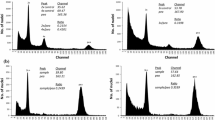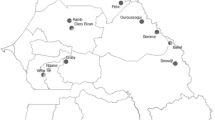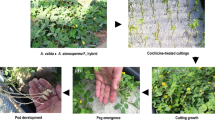Abstract
Colchicine-induced neoautotetraploid genotypes of Acacia mangium were cloned and planted in mixture with a set of diploid clones in an orchard in southern Vietnam. Following good general flowering, open-pollinated seed was collected from trees of both cytotypes and microsatellite markers were used to determine the breeding system as characterised by the proportion of outcrosses in young seedling progeny. As predicted from the literature, the progeny of diploid clones were predominantly outcrossed (t m = 0.97). In contrast, the progeny of the tetraploid clones were almost entirely selfs (t m = 0.02; 3 of 161 seedlings assayed were tetraploid outcrosses and there were no triploids). Segregation at loci heterozygous in the tetraploid mothers followed expected ratios, indicating sexual reproduction rather than apomixis. Post-zygotic factors are primarily responsible for divergence of the breeding systems. Commonly, less than 1 % of Acacia flowers mature as a pod, and after mixed pollination, diploid outcrossed seed normally develops at the expense of selfs. Selfs of the tetraploid trees appear to express less genetic load and have a higher probability of maturing. However, this does not fully explain the observed deficiency of outcross tetraploid progeny. Presumably, there are cytogenetic reasons which remain to be investigated. In nature, selfing would increase the probability of establishment of neotetraploids irrespective of cytotype frequency in the population. Breeders need to review their open-pollinated breeding and seed production strategies. It remains to be seen whether this is an ephemeral problem, with strong fertility selection restoring potential for outcrossing over generations.
Similar content being viewed by others
References
Andrew RL, Miller JT, Peakall R, Crisp MD, Bayer RJ (2003) Genetic, cytogenetic and morphological patterns in a mixed mulga population: evidence for apomixis. Aust Syst Bot 16:69–80
Barrett SCH, Harder LD, Worley AC (1996) The comparative biology of pollination and mating in flowering plants. Philos Trans R Soc Lond B Biol Sci 351:1271–1280
Barringer BC (2007) Polyploidy and self fertilisation in flowering plants. Am J Bot 94:1527–1533
Bayer RJ, Ritland K, Purdy BG (1990) Evidence of partial apomixis in Antennaria media (Asteraceae, Inuleae) detected by segregation of genetic markers. Am J Bot 77:1078–1083
Blakesley D, Allen A, Pellny TK, Roberts AV (2002) Natural and induced polyploidy in Acacia dealbata Link. and Acacia mangium Willd. Ann Bot 90:391–398
Briggs D, Walters SM (1997) Plant variation and evolution, 3rd edn. Cambridge University Press, Cambridge
Bukhari YM (1997) Cytoevolution of taxa in Acacia and Prosopis (Mimosaceae). Aust J Bot 45:879–891
Butcher PA, Decroocq S, Gray Y, Moran GF (2000) Development, inheritance and cross-species amplification of micro-satellite markers from Acacia mangium. Theor Appl Genet 101:1282–1290
Butcher PA, Harwood CE, Quang TH (2004) Studies of mating systems in seed stands suggest possible causes of variable outcrossing rates in natural populations of Acacia mangium. For Genet 11:303–309
Byrne M (2008) Phylogeny diversity and evolution of eucalypts. In: Sharma AK, Sharma A (eds) Plant genome biodiversity and evolution, vol 1 Part E. Science Publishers, Enfield, pp 303–346
Chi QN, Harwood CE, Harbard JL, Griffin AR, Koutoulis A, Thinh HH (2011) Floral phenology and morphology of colchicine-induced tetraploid Acacia mangium compared with diploid A. mangium and A. auriculiformis: implications for interploidy pollination. Aust J Bot 59:582–592
Cook LM, Soltis PS (1999) Mating systems of diploid and allotetraploid populations of Tragopogon (Asteraceae). I. Natural populations. Heredity 82:237–244
Crnokrak P, Barrett SC (2002) Perspective: purging the genetic load: a review of the experimental evidence. Evolution 56:2347–2358
Esselink GD, Nybom H, Vosman B (2004) Assignment of allelic configuration in polyploids using the MAC-PR (microsatellite DNA allele counting-peak ratios) method. Theor Appl Genet 109:402–408
Glemin S (2003) How are deleterious mutations purged? Drift versus non-random mating. Evolution 57:2678–2687
Griffin AR, Moran GF, Fripp YJ (1987) Preferential outcrossing in Eucalyptus regnans. Aust J Bot 35:465–475
Griffin AR, Vuong TD, Harbard JL, Wong CY, Brooker C, Vaillancourt RE (2010) Improving controlled pollination methodology for breeding Acacia mangium Willd. New For 40:131–142
Griffin AR, Midgley SJ, Bush D, Cunningham PJ, Rinaudo AT (2011) Global uses of Australian acacias—recent trends and future prospects. Divers Distrib 17:837–847
Grimanelli D, Leblanc O, Espinosa E, Perotti E, De Leon DG, Savidan Y (1998) Non-Mendelian transmission of apomixis in maize-Tripsacum hybrids caused by a transmission ratio distortion. Heredity 80:40–47
Harbard JL, Griffin AR, Foster S, Brooker C, Kha LD, Koutoulis A (2012) Production of colchicine-induced autotetraploids as a basis for sterility breeding in Acacia mangium Willd. Forestry 85:427–436
Harwood CE, Thinh HH, Quang TH, Butcher PA, Williams ER (2004) The effect of inbreeding on early growth of Acacia mangium in Vietnam. Silvae Genet 53:65–69
Husband BC (2004) The role of triploid hybrids in the evolutionary dynamics of mixed-ploidy populations. Biol J Linn Soc 82:537–546
Husband BC, Schemske DW (1997) Effects of inbreeding in diploid and tetraploid populations of Epilobium angustifolium: implications for the genetic basis of inbreeding depression. Evolution 51:737–746
James SH, Kennington WJ (1993) Selection against homozygotes and resource allocation in the mating system of Eucalyptus camaldulensis Dehnh. Aust J Bot 41:381–391
Kenrick J (2003) Review of pollen-pistil interactions and their relevance to the reproductive biology of Acacia. Aust Syst Bot 16:119–130
Kenrick J, Knox RB (1982) Function of the polyad in reproduction of Acacia. Ann Bot 50:721–727
Kenrick J, Knox RB (1989) Quantitative analysis of self-incompatibility in trees of seven species of Acacia. J Hered 80:240–245
Kha LD, Griffin AR, Thinh HH, Harbard JL, Son L, Hoa DT, Chi NQ (2009) “Research on ploidy identification and characterisation of Acacia mangium tetraploids in comparison with diploid clones in Vietnam”. Sci Technol J Agric Rural Dev 9:114–120 (Eng. Summary)
Lande RD, Schemske W (1985) The evolution of self-fertilization and inbreeding depression in plants. I. Genetic models. Evolution 39:24–40
Levin DA (1975) Minority cytotype exclusion in local plant populations. Taxon 24:35–43
Levin DA (1983) Polyploidy and novelty in flowering plants. Am Nat 122:1–25
Mable BK (2004) Polyploidy and self-compatibility: is there an association? New Phytol 162:803–811
McGowen MH, Vaillancourt RE, Pilbeam DJ, Potts BM (2010) Sources of variation in self-incompatibility in the Australian forest tree Eucalyptus globulus. Ann Bot 105:737–745
Midgley SJ, Turnbull JW (2003) Domestication and use of Australian acacias: case studies of five important species. Aust Syst Bot 16:89–102
Miller JT, Andrew RA, Maslin BR (2002) Towards an understanding of variation in the Mulga complex (Acacia aneura and relatives). Cons Sci West Aust 4:19–35
Moran GF, Muona O, Bell JC (1989a) Acacia mangium: a tropical forest tree of the coastal lowlands with low genetic diversity. Evolution 43:231–235
Moran GF, Muona P, Bell JC (1989b) Breeding systems and genetic diversity in Acacia auriculiformis and A. crassicarpa. Biotropica 21:250–256
Moran G, Thomson L, Grant J, Bell C (1992) Distribution of genetic variation within two species of dry-zone acacia species and implications for their genetic improvement. In: House APN, Harwood CE (eds) Australian dry zone acacias for human food. CSIRO, Australia, pp 74–81
Ng CH, Lee SL, Ng KKS, Norwati M, Wickneswari R (2009) Mating system and seed variation of Acacia hybrid (A. mangium × A.auriculiformis). J Genet 88:25–31
Otto SP (2007) The evolutionary consequences of polyploidy. Cell 131:452–462
Pedley L (1973) Taxonomy of the Acacia aneura complex. Trop Grassl 7:3–8
Ramsey J, Schemske DW (2002) Neopolyploidy in flowering plants. Ann Rev Ecol Syst 33:589–639
Richardson DM, Carruthers J, Hui C, Impson FAC, Miller JT, Robertson MP, Rouget M, Le Roux JJ, Wilson JRU (2011) Human-mediated introductions of Australian acacias—a global experiment in biogeography. Divers Distrib 17:771–787
Ritland K (2002) Extensions of models for the estimation of mating systems using n independent loci. Heredity 88:221–228
Sampson JF (1998) Multiple paternity in Eucalyptus ramelliana (Myrtaceae). Heredity 81:349–355
Scofield DG, Schultz ST (2006) Mitosis, stature and evolution of mating systems: low- and high-plants. Proc R Soc Lond B Biol Sci 273:275–282
Sedgley M, Harbard JL (1993) Pollen storage and breeding system in relation to controlled pollination of four species of Acacia (Leguminosae:Mimosoideae). Am J Bot 41:601–609
Sedgley M, Harbard J, Smith RMM, Wickneswari R, Griffin AR (1992) Reproductive biology and interspecific hybridization of Acacia mangium and Acacia auriculiformis (Leguminosae, Mimosoideae). Aust J Bot 40:37–48
Soltis DE, Soltis PS, Tate JA (2003) Advances in the study of polyploidy since plant speciation. New Phytol 161:173–191
Sornsathapornkul P, Owens JN (1998) Pollination biology in a tropical Acacia hybrid (A. mangium Willd. × A. auriculiformis A. Cunn. ex Benth.). Ann Bot 81:631–645
Stebbins GL (1956) Artifical polyploidy as a tool in plant breeding. Brookhaven Symp Biol 9:37–52
Stone GN, Raine NE, Prescott M, Willmer PG (2003) Pollination ecology of acacias (Fabaceae, Mimosoideae). Aust Syst Bot 16:103–118
Suitor S, Potts BM, Brown PH, Gracie AJ, Gore PL (2008) Post-pollination capsule development in Eucalyptus globulus seed orchards. Aust J Bot 56:51–58
Sybenga J (1969) Allopolyploidization of autopolyploids. I. Possibilities and limitations. Euphytica 18:355–371
Tybirk K (1997) Reproductive biology and evolution of the genus Acacia. Bull Int Group Study Mimosoideae 20:45–53. http://www.worldwidewattle.com/socgroups/igsm/bulletin.php
Wang XW, Cui KM (2000) The effect of age and multiploidy on fiber of Acacia mangium. Scientia Silvae Sinicae 36:125–130 (Eng. Summary)
Whitton J, Sears CJ, Baack EJ, Otto SP (2008) The dynamic nature of apomixis in the angiosperms. Int J Plant Sci 169:169–182
Acknowledgments
The post-graduate studies of TDV and CQN at the University of Tasmania were supported by John Allwright Scholarships from the Australian Centre for International Agricultural Research (ACIAR). ARG, JH and CEH acknowledge support from ACIAR Project FST2008/007. Mr La Ngoc Hong from FSIV harvested and extracted the seeds and Mr Tran Ho Quang assisted with DNA extraction. We would also like to acknowledge the help of Rebecca Jones, James Marthick and Adam Smolenski with molecular analysis.
Author information
Authors and Affiliations
Corresponding author
Additional information
Communicated by Andrew Stephenson.
Rights and permissions
About this article
Cite this article
Griffin, A.R., Vuong, T.D., Vaillancourt, R.E. et al. The breeding systems of diploid and neoautotetraploid clones of Acacia mangium Willd. in a synthetic sympatric population in Vietnam. Sex Plant Reprod 25, 257–265 (2012). https://doi.org/10.1007/s00497-012-0195-2
Received:
Accepted:
Published:
Issue Date:
DOI: https://doi.org/10.1007/s00497-012-0195-2




